Introduction - Higher Education Statistics 2009/10
In 2009/10, there were 165 publicly-funded higher education institutions (HEIs) in the UK. HESA holds data on these 165 institutions plus the privately funded institution, The University of Buckingham. The HESA student record does not include any data for The University of Wales (central functions) which has staff but no students. This publication brings together student, staff and finance data collected by HESA at these UK institutions; application and acceptances data from UCAS; student loan information from Student Loans Company (SLC); participation rates from OECD plus contextual population statistics from Office for National Statistics.
Applications and acceptances
The majority of UK domiciled full-time undergraduate students apply to UK HEIs through the UCAS application system. In 2009/10, there were 639,860 applicants to full-time higher education via UCAS, of which 481,855 (or around three quarters) were accepted. Table A [xls 25 KB] and Chart 1 illustrate the UCAS applicants and acceptances alongside the numbers of full-time undergraduate entrants studying at UK HEIs. The number of part-time undergraduate entrants is shown for comparison purposes. It is important to be aware that the coverage of UCAS data differs from that of the HESA data, so the graph may be used to analyse the trend, rather than for direct number comparisons. A decline in the number of applicants, acceptances and full-time undergraduate entrants can be seen in 2006/07 which ties in with the introduction of variable fees.
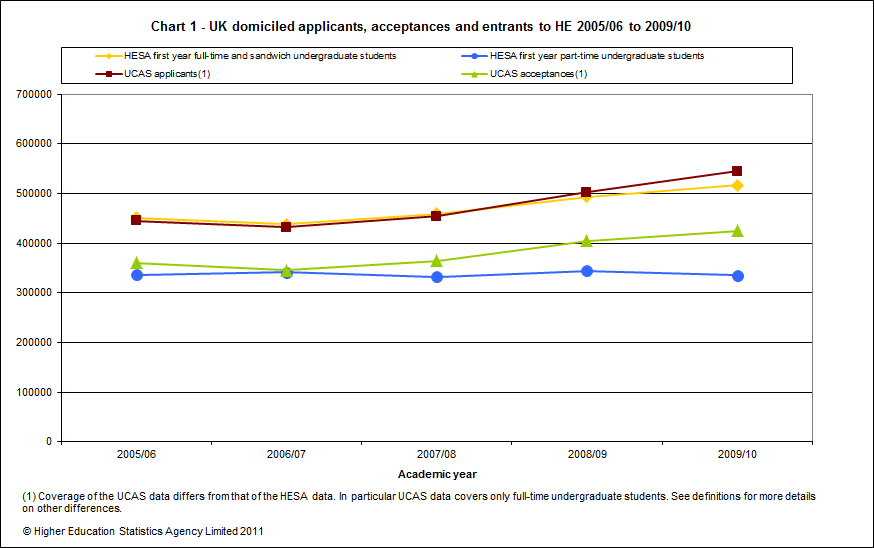
Student population
There were 2.49 million students studying for a HE qualification or for HE credit at HEIs in the UK in 2009/10. Over the past five years, the number of HE students studying at UK HEIs has been gradually increasing, an overall increase of 9.3%. Since 2007/08, the increase has been more apparent with an 8.1% rise in the last two years.
An additional 59,835 students were known to be studying at further education (FE) level at UK HEIs, although this is likely to be an undercount as institutions are no longer required to return their FE data to HESA. Data on FE students at HEIs have therefore been excluded from the remainder of the introduction.
Table B [xls 34 KB] provides more detail on students by level of study with comparisons between full-time and part-time, where full-time includes those following a full-time or sandwich programme. It can be seen that a much higher proportion of full-time students were studying for a first degree than of part-time students who were more likely to be studying for another type of undergraduate qualification. For context, Table B [xls 34 KB] also includes data on HE level students studying at FE institutions in the UK.
Equivalent information on students studying at further education level can be found in the current Statistical First Release from The Data Service and the Department for Business, Innovation and Skills.
Nearly half (48.5%) of the 2,493,420 HE students were following a full-time first degree programme. The following pie chart illustrates the breakdown of HE students by level and mode of study.
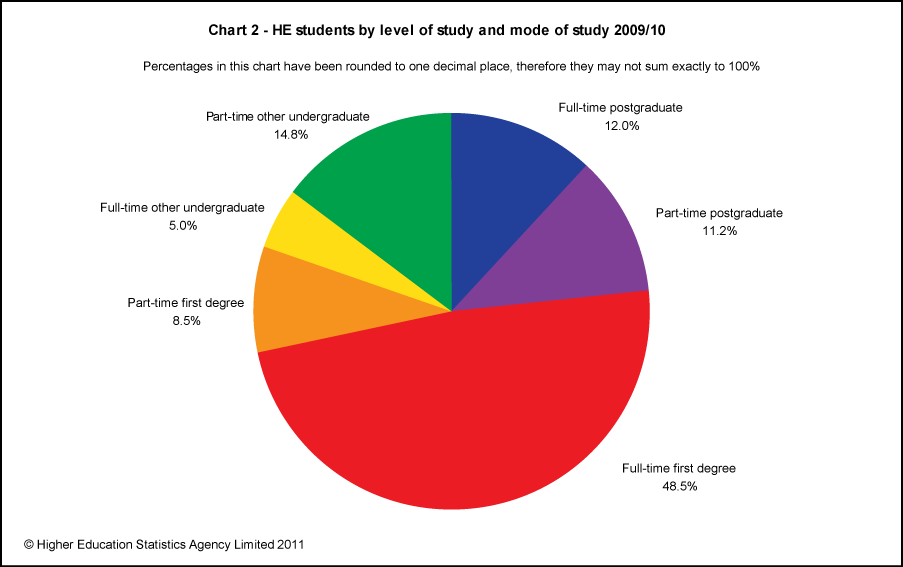
Gender and domicile
A higher proportion of female students (56.6%) than male students (43.4%) were studying at HEIs in the UK. The gender imbalance was more noticeable among students studying part-time of which 61.3% were female. It was also apparent across region of domicile; of those non-EU domicile students, a higher proportion were male (55.3%) than female (44.7%).
Table C [xls 34 KB] illustrates the differences in student numbers by domicile, gender, level and mode of study.
Subject of study
Table D [xls 35 KB] shows the distribution of student numbers by subject varied by level of study.
High proportions of other undergraduate students studied subjects allied to medicine (26.1%) and in combined subject areas (15.2%). The high proportion in subjects allied to medicine can be explained because a qualification below first degree level is the norm in many health-related professions, especially nursing. Many Open University students may not initially have to declare their award intention and are reported as studying for institutional credit in the combined subject area. For both postgraduate and first degree students, the highest proportions were studying Business & administrative studies.
Chart 3 below provides the numbers of HE students by subject area and level of study.
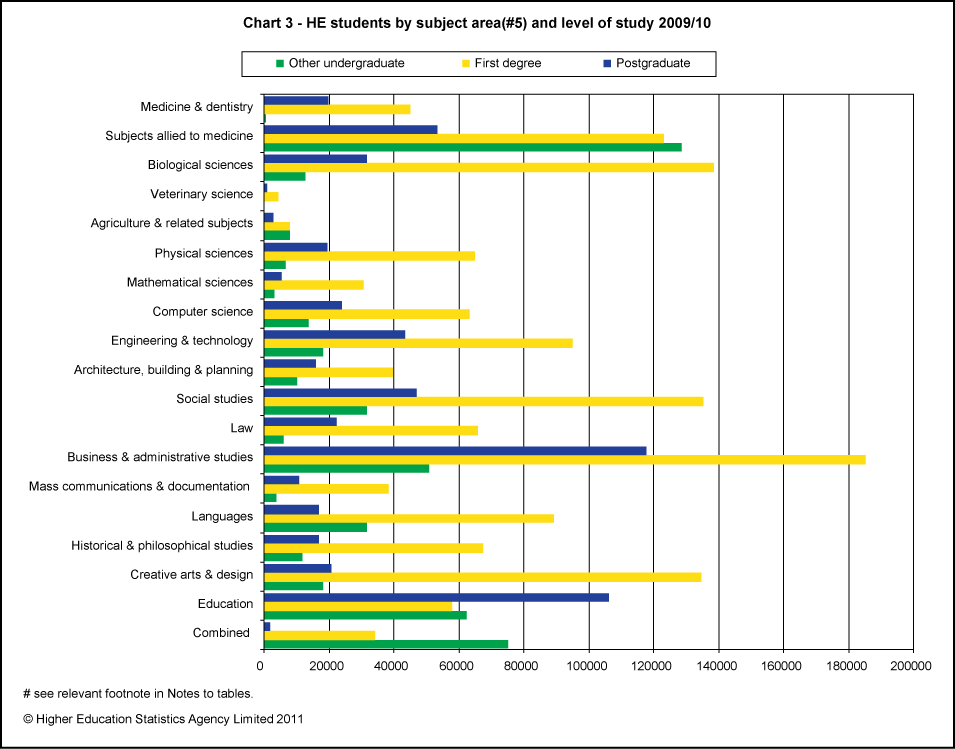
Qualifications obtained
In 2009/10 a total of 716,940 qualifications were awarded at HE level to students at UK HEIs. Of these, 31.6% were at postgraduate level, 48.9% were first degree qualifications and 19.5% were other undergraduate qualifications. Chart 4 below illustrates this.
Over the period of 2005/06 to 2009/10 the total number of first degree qualifiers increased by 11%. This largely reflects the increasing numbers of entrants in earlier years feeding through the system. Table E [xls 33 KB] provides a more detailed breakdown of qualifications obtained for the last five years.
Information on rates of completion for full-time first degrees are published separately in the ‘Projected Outcomes’ tables of the HESA Performance Indicators. These completion rates require two consecutive years’ data to produce so there is a time lag of one year between the latest data available (2009/10), and the latest completion rates (2008/09). The statistics show that the projected completion rate for full time first degrees increased slightly from 77.6% of 2004/05 entrants to 78.8% of 2008/09 entrants.
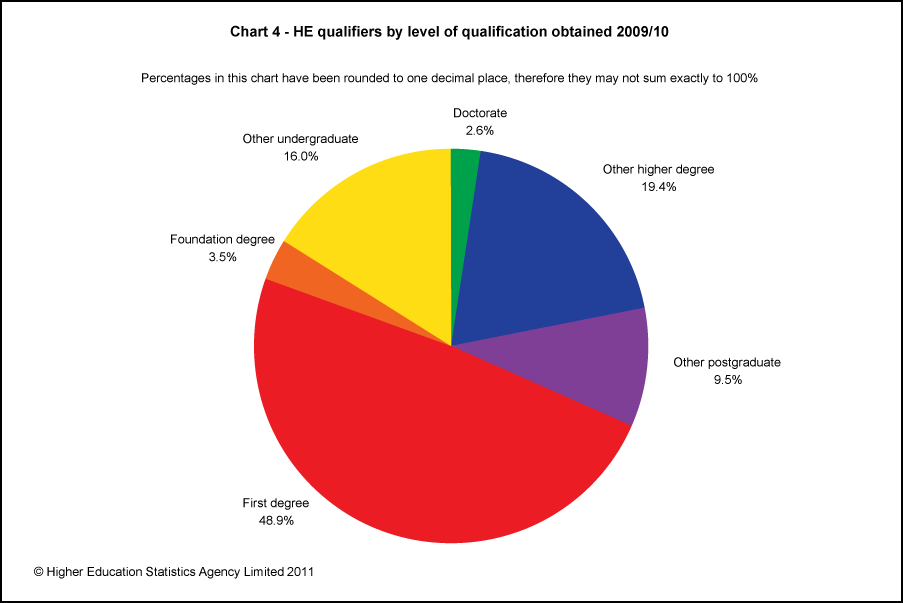
Destinations of leavers
Approximately six months after leaving their HEI, the majority of UK and other EU qualifiers were surveyed with regards to their employment and further study activity. This Destinations of Leavers from Higher Education (DLHE) survey includes those qualifiers who completed their programmes during the academic year 2009/10. The reference date for those obtaining the qualification between 1 August 2009 and 31 December 2009 was 19 April 2010, and the reference date for those obtaining the qualification between 1 January 2010 and 31 July 2010 was 10 January 2011.
In 2009/10, there were 379,865 qualifier responses of known destination from 501,540 qualifiers within the eligible DLHE population. This gives a percentage with known destination of 75.7%, an increase of 0.4% since 2008/09. A further 15,940 qualifiers replied to the survey but explicitly declined to give information. Including the explicit refusals, the overall response rate was 78.9%. Table F [xls 31 KB] provides a breakdown of leavers’ activity by level of qualification obtained.
Table G [xls 31 KB] illustrates the proportions of leavers by activity for the last five years. The proportion of leavers in employment fell for two consecutive years from 2006/07 to 2008/09, roughly coinciding with the wider economic downturn. The proportion of leavers assumed to be unemployed rose over the same period. From 2008/09 to 2009/10 there was a slight rise in the proportion of leavers entering employment. The proportion of leavers entering voluntary or other unpaid work gradually rose over the whole five year period.
The following pie charts show comparatively the proportion of leavers by activity for postgraduate, first degree and undergraduate leavers. Around two thirds (66.0%) of postgraduate leavers entered full-time paid work only. The proportion was closer to a half (49.3% and 45.1%) for first degree and other undergraduates respectively. First degree leavers were more likely to be unemployed (8.7%) than postgraduates (5.6%) and other undergraduates (4.3%). Over a third of other undergraduates were engaged in study, either through a combination of work and further study (18.5%) or further study only (19.3%).
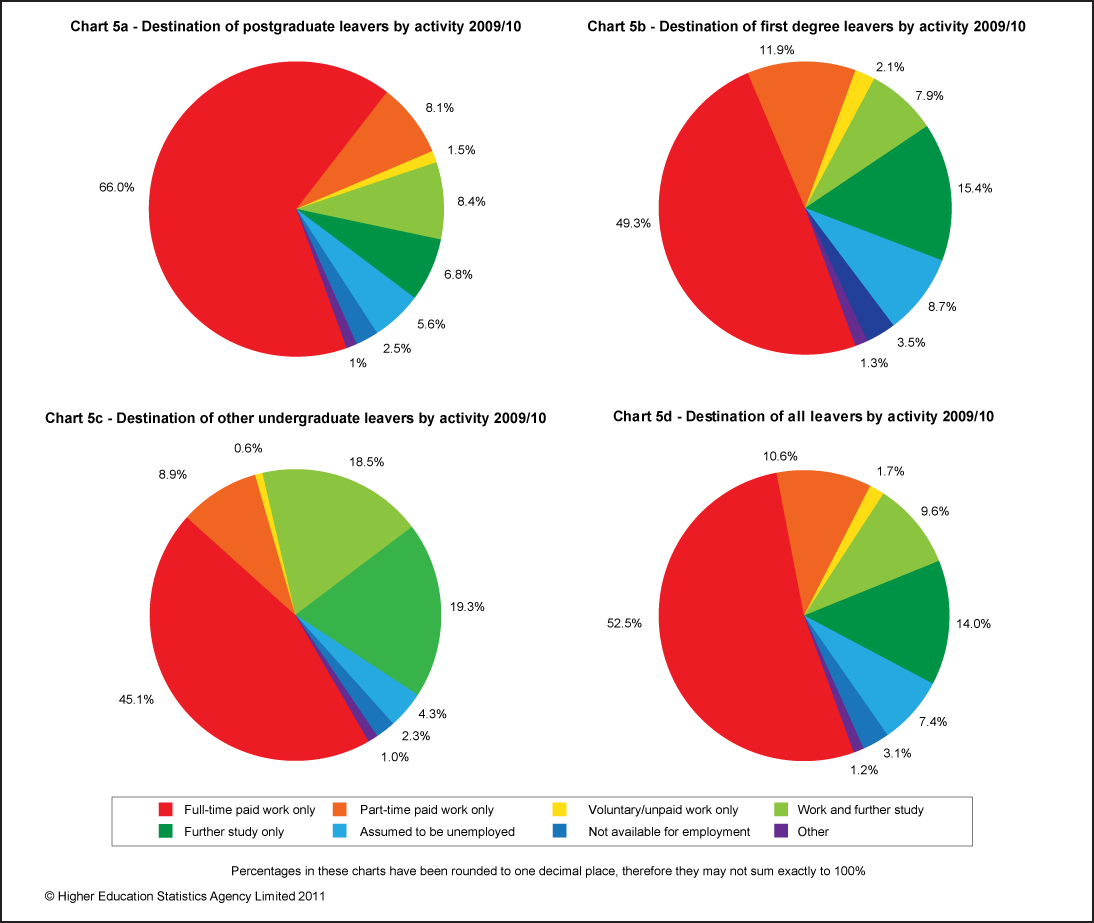
Staff
The HESA Staff Record covers all academic and non-academic staff who have a contract of employment with a higher education institution (HEI) in the UK, or for whom the HEI is liable to pay Class 1 National Insurance contributions.
On 1 December 2009, there were in total, but excluding those staff on atypical1 contracts, 387,430 staff, of whom 181,595 were academic and 205,835 were non-academic. In addition, there were 183,155 staff on atypical contracts.
The remainder of the staff figures exclude atypical staff. Table H [xls 32 KB] provides a breakdown by activity and mode of employment for the last five years.
In line with the increase in student numbers over the last five years, overall staff numbers have increased by 9.0% and academic staff numbers have increased by 10.1%. Staff numbers increased steadily between 2005/06 and 2008/09, with slower growth between 2008/09 and 2009/10.
Chart 6 illustrates the increasing trend of both students and academic staff over a five year period. It should be noted that the axis scale for staff differs from that of students in order to express both trends on the same chart.
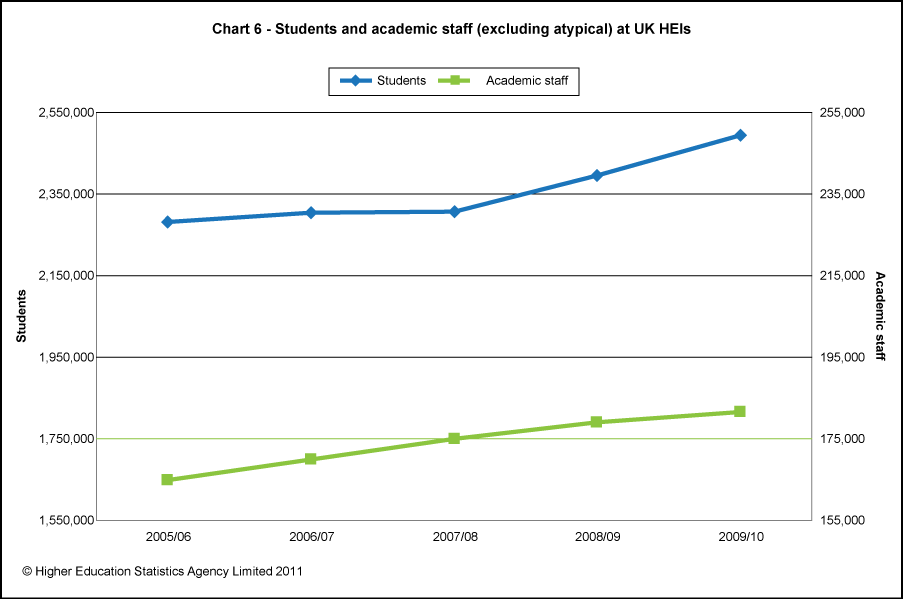
Table I [xls 33 KB] below shows academic staff by academic employment function, gender, mode of employment and terms of employment for 2009/10. Overall, there was a higher proportion of male academic staff than female. However, higher proportions of part-time academic staff were female. This was true for both open-ended/permanent and fixed-term contracts.
Chart 7 below illustrates the proportions of open-ended/permanent and fixed-term contract academic staff by academic employment function, mode of employment and gender. It can be seen that staff engaged in both teaching and research were much more likely to be employed on open-ended/permanent contracts than those undertaking only research.
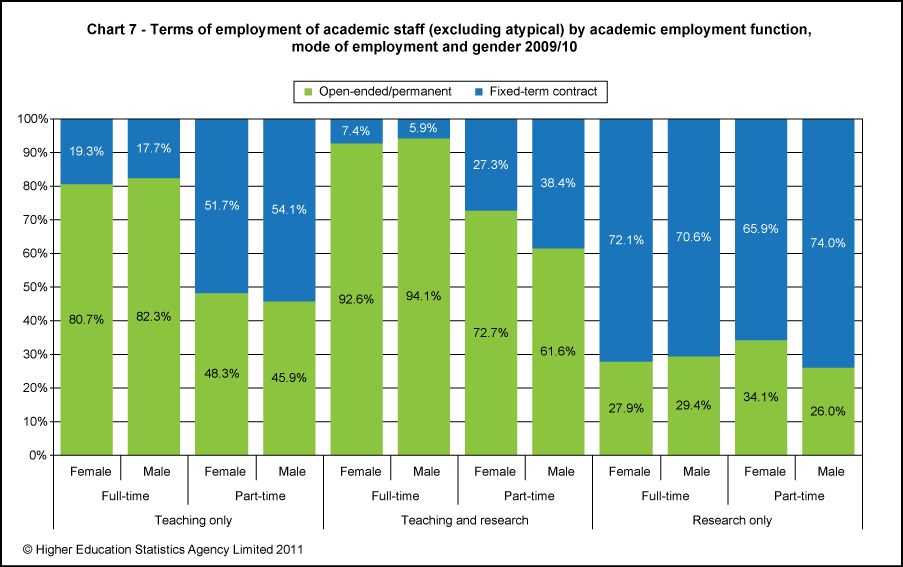
Finance
The finance data collected by HESA from UK HEIs covers income and expenditure. Over the last five years, income and expenditure have gradually increased at a similar rate, tapering off during the last year. Income has increased at a slightly higher rate (37.2% increase since 2005/06) than expenditure (33.6% increase since 2005/06) with a HE sector surplus across all years. Over the last five years, the percentage increase in income and expenditure (in cash terms) has been over three times that of student and staff numbers over the same period.
Table J [xls 31 KB] provides a time series of the various income and expenditure streams for the last five years. Chart 8 illustrates the proportional change of the various sources of income over the same period. In particular, the proportion of income from tuition fees and education contracts has increased from 23.9% in 2005/06 to 30.9% in 2009/10.
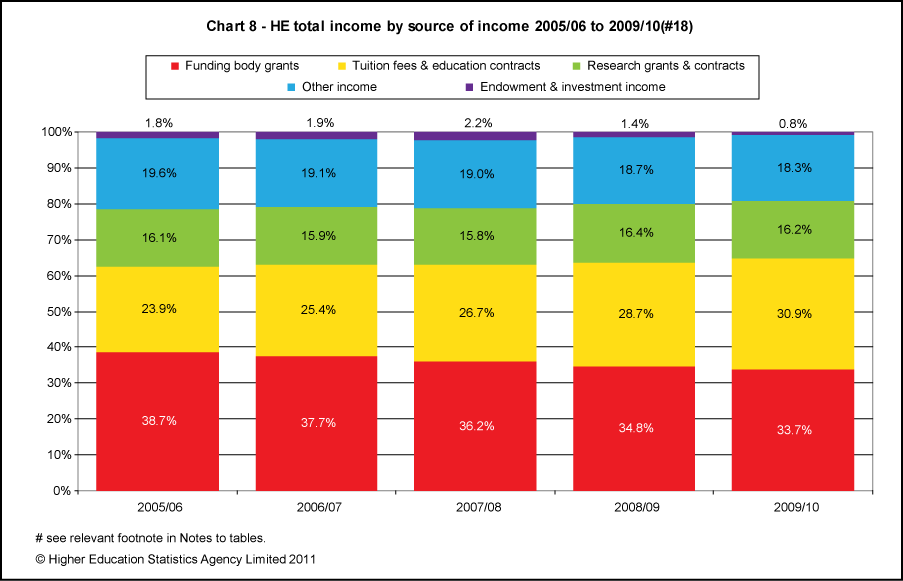
Student Loans
Table K [xls 33 KB] provides information on income from course fees of full-time UK and EU domicile undergraduates (source: HESA) alongside tuition fee loans and maintenance loans paid to HE students (source: SLC). Although difference in coverage means that data from these two sources are not directly comparable, the figures allow some trend comparisons to be made. Although income of HEIs and loans paid to HE students have all increased over time, the tuition fee loans paid to HE students have increased at a faster rate.
- See Definitions, Section F for explanation of atypical staff.
© Higher Education Statistics Agency Limited 2011
